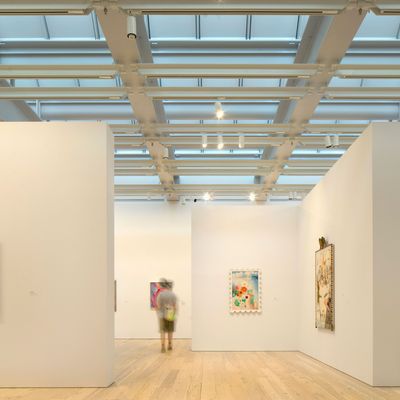
The Whitney Biennial this year has been celebrated as a much-needed sanctuary, one that has served as both a salve and an affirmation of the swirl of political feelings many people are currently going through. But that doesn’t mean it has been without controversy: A group of artists are asking that a painting of Emmett Till’s dead body, titled Open Casket by white artist Dana Schutz, be removed from the exhibit, saying that the painting uses black suffering for “profit and fun,” and that the artist’s depiction treats “Black pain as raw material.”
The painting depicts the unforgettable image of 14-year-old Emmett Till’s dead body in an open casket at his funeral. Till was lynched in Mississippi in 1955 after he was falsely accused of flirting with a white woman, and his mother, Mamie Till, made the decision to have an open-casket funeral, saying, “Let the people see what I’ve seen.” At the Biennial’s opening on Friday, a small protest was staged in front of the painting, in an attempt to block it from view:
That even the disfigured corpse of a child was not sufficient to move the white gaze from its habitual cold calculation is evident daily and in a myriad of ways, not least the fact that this painting exists at all. In brief: the painting should not be acceptable to anyone who cares or pretends to care about Black people because it is not acceptable for a white person to transmute Black suffering into profit and fun, though the practice has been normalized for a long time.
Although Schutz’s intention may be to present white shame, this shame is not correctly represented as a painting of a dead Black boy by a white artist — those non-Black artists who sincerely wish to highlight the shameful nature of white violence should first of all stop treating Black pain as raw material. The subject matter is not Schutz’s; white free speech and white creative freedom have been founded on the constraint of others, and are not natural rights. The painting must go.
The full letter, which was co-signed by over 25 black members of the arts community, is available here. As for the Whitney’s response, the Biennial’s curators, Christopher Y. Lew and Mia Locks, have defended the painting’s importance. They sent the following statement to Artnet news:
“The 2017 Whitney Biennial brings to light many facets of the human experience, including conditions that are painful or difficult to confront such as violence, racism, and death. Many artists in the exhibition push in on these issues, seeking empathetic connections in an especially divisive time. Dana Schutz’s painting, Open Casket (2016), is an unsettling image that speaks to the long-standing violence that has been inflicted upon African Americans. For many African Americans in particular, this image has tremendous emotional resonance. By exhibiting the painting we wanted to acknowledge the importance of this extremely consequential and solemn image in American and African American history and the history of race relations in this country. As curators of this exhibition we believe in providing a museum platform for artists to explore these critical issues.”
We’ll continue to update this story as more information comes in.
Update, 3/21/17, 1:53p.m.: Dana Schutz emailed the Guardian with the following statement on the controversy: “I don’t know what it is like to be black in America, but I do know what it is like to be a mother. Emmett was Mamie Till’s only son. The thought of anything happening to your child is beyond comprehension. It is easy for artists to self-censor, to convince yourself to not make something before you even try. There were many reasons why I could not, should not, make this painting … (but) art can be a space for empathy, a vehicle for connection.” She also noted that the artwork will not be for sale.

